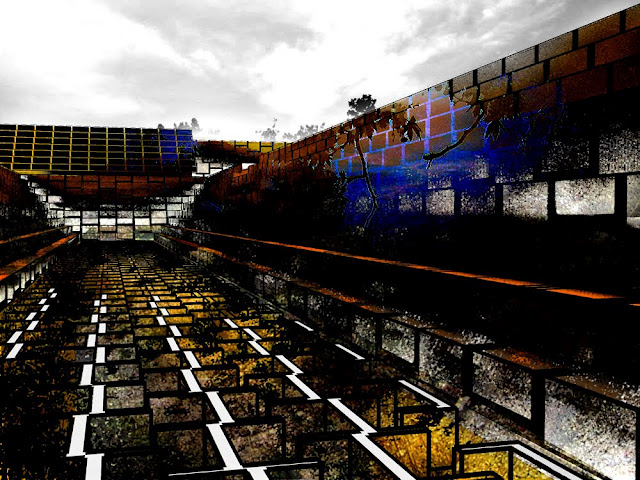

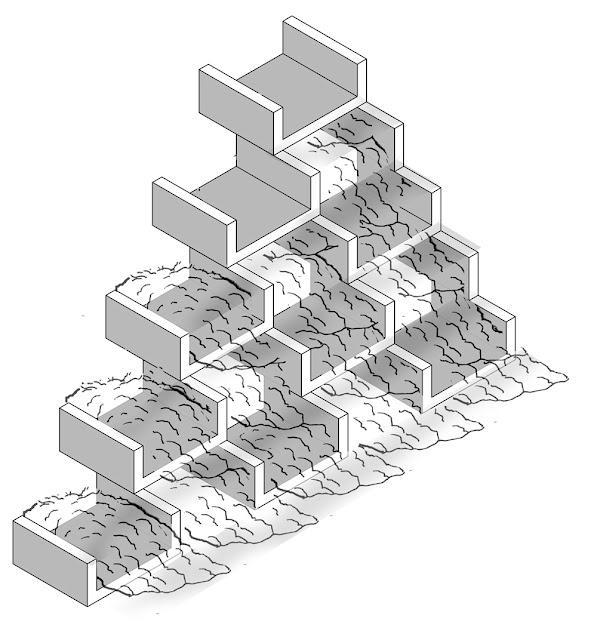

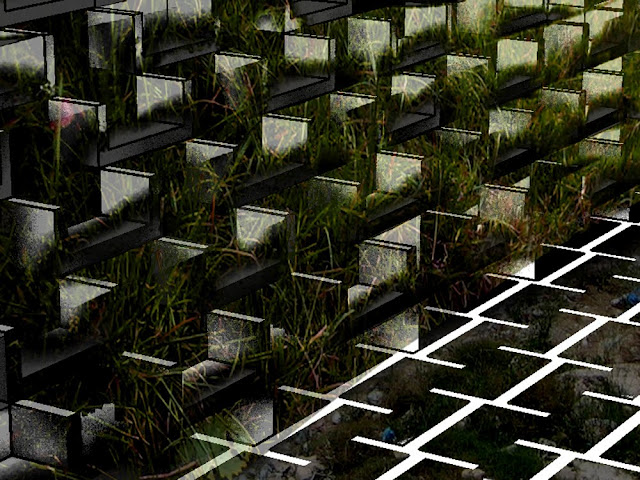

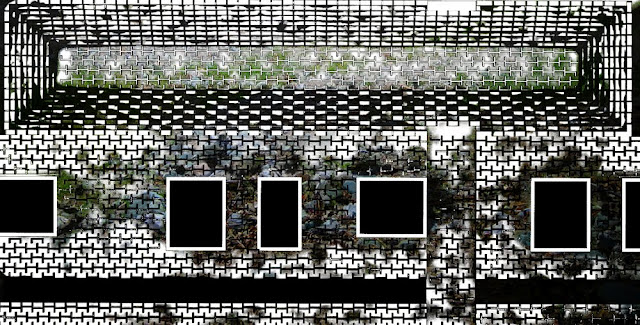

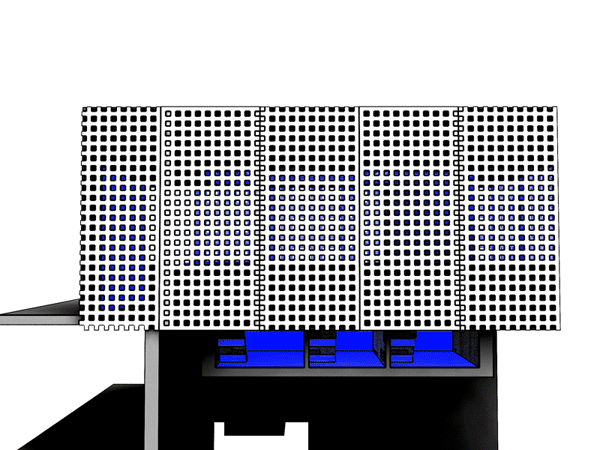

This proposal elaborates the modern cheap building construction practices in Greece and uses them in the same country and for the same reason, the habitation.
The Greek word “Giapi” describes an unfinished construction, which often is abandoned and so produces an open space situation with a variety of uses and definitions.
The first idea of the project is the tilting over of one Giapi into a stream named “Krafsidonas”.
In this way a new horizontal skeleton in the stream is created, which connects both shores of the river. These bridges form the primary structure which contains smaller (secondary) skeletons. The secondary skeletons are at different stages of completion depending on their position in the large frame skeleton.
So the big skeleton contains 37 properties resulting from the repeating of three different types.
The three types come from the study and transformation of a floor plan of a typical Greek multi-storey building which contains 3 apartments.
Six of the 37 properties from the primary structure are at a degree of completion, which allows to occupy them. The others are in an earlier state, each of them in a different depending on their position in the primary skeleton.
Anyhow the area covered by the property and the access to it is the same for all of them.
The territory of the river and the bridges is not for sale or rent, only the secondary structures can be owned. The price depends on the degree of completion of each property.
The river and the bridges will continue to be public with open access as now.
An unsold property will be open to everyone as every public building, but without declaration of a specific use.
Six theaters are placed vertical in flow direction in the river bed. They slow down the speed of the water of the river creating vortices and stare large amounts of water, which is vital for the territory between the dry periods.
The project provides a property with low privacy. The rooms of each property with their different functions are spread across different floors and therefore it is necessary to cross the public area to go from one room to another.
The project follows a new logic of design – there is no separation of the design and construction period and time of inhabitation. A space changing over time is created. The intervention of humans is its meaning. It can be changes by natural or urban events and acts as a filter of the river. It invites the people to relationships of cooperation or confliction between them.
Supervisor: Paniyiris Costis
File: Anna.Vasof.UnderConstruction.pdf
Reference Number: 268
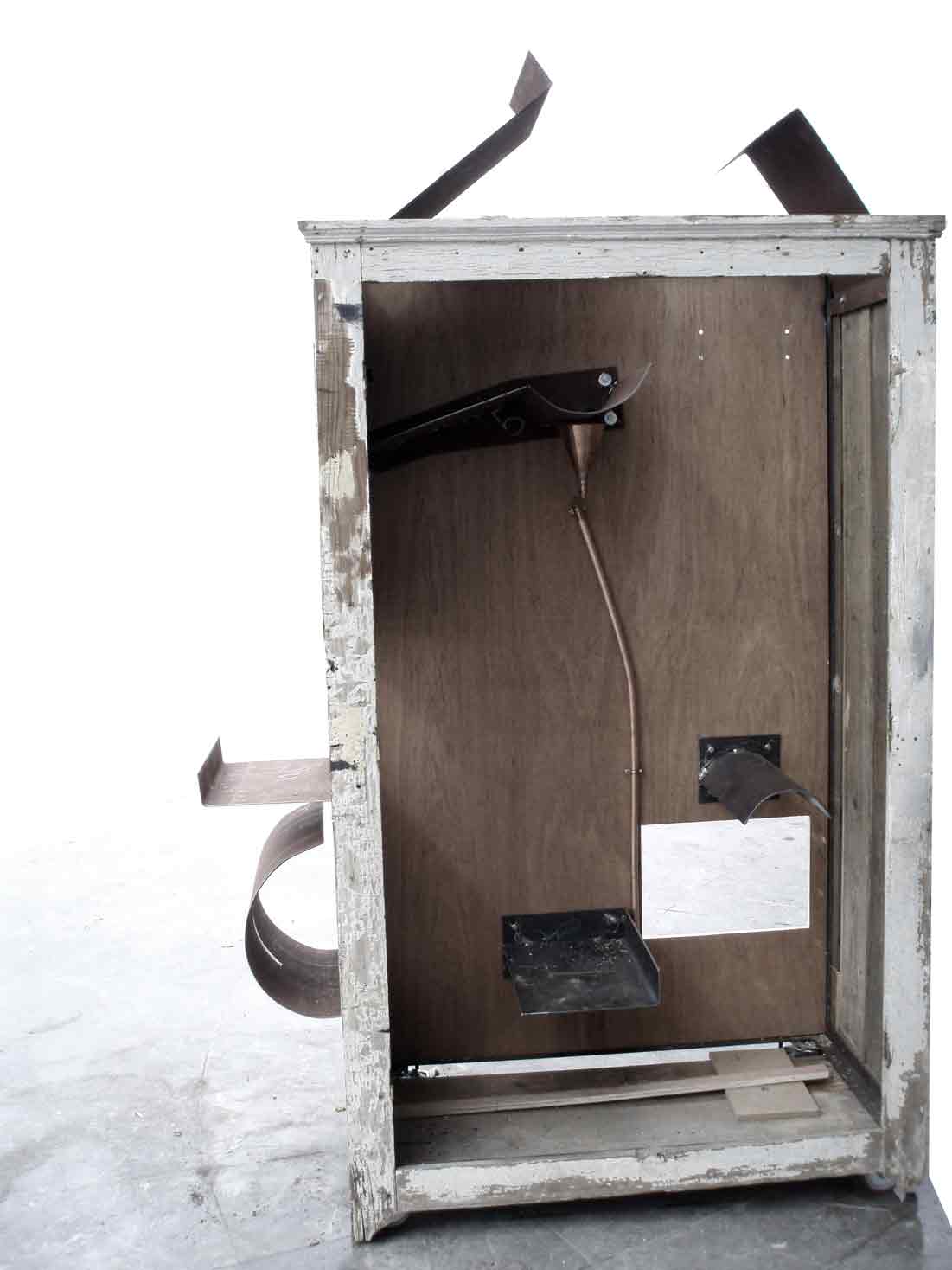

This degree thesis is based on George Bataille’s book ‘Story of the Eye’. The book refers to a teenage couple, who through a series of actions invents ways of physical expression, bringing out the dark side of eroticism. Bataille wavers between human materiality (the dying body) and corporal apotheosis (the body during erotic flare). Through the compilation of selected extracts which constitute either kinesiological snap-shots or descriptions of human behaviour under extreme circumstances, arises a new understanding of the notion of corporality and the management of eroticism as a ‘desire’. Through studying the space between the lovers and having set as a design basis a cabinet (the cabinet consists spatial element from the book), emerges a chamber, as a condition of enclosure, during which one is inside and one is outside. The subjects are found in distance. The transformation of the cabinet to a chamber aims to intensify the erotic desire through the unsettled relation between master and dominated. The interventions are fragments of sheet metal which are placed in order for the body to maintain specific positions, which derive from the book. Viewing for both of the subjects is limited. The chamber is an imaginary place.
Supervisors: Antonas Aristide, Psychoulis Alexandros
Reference Number: 263


The urbanism of the countryside and the urban dispersal create a new setting of human installation in connection with the scenery, which is continually changing. The means of transport change the distances so as to be pertained more with time measurements(hours) rather than distances(km). The country placement is a periodic placement having as a main fact the consumption of the exochikotita, tamed and alleged in standard and measures of a "civilized" man. The scenery has changed to such a degree, that the human presence is located everywhere in the scenery, the "virgin" nature which is played by documentaries does not exist anymore. The presence of cables, construction waste and roads in general, are parts of the new exochikotita. The exochikotita is spotted in the distorted nature, a nature with integral part, the presence of the human element.
The diploma opens new νέους conditions of a country multi-housing in the altered landscapes. The places of the country housing which are recommended in the diploma are the altered landscapes and more specifically the landscapes between the road system and the sea which have the intense element of the pitch of the slope. The slopes, spotted in the sides of the roads. The tense slopes, result of human intervention in the landscape, " JET GROUTING ", the living in 9˚ and the phrase of P. Giannopoulou «The living in Greece is living outdoor», is the general line of diploma. Also, it examines the relation between the of city- apartment, with the multi-housing in country. Sun, air, land, water and the harmonization of built space with the environment, express a new outdoor living.
Supervisor: Paniyiris Costis
Reference Number: 275
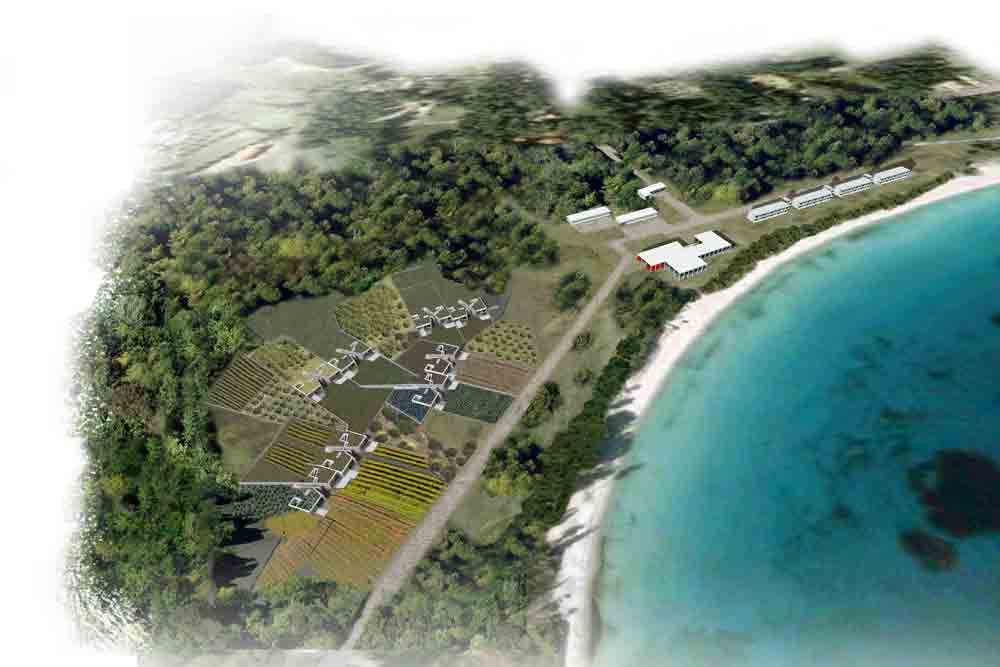

The object of our diploma thesis is the planning of a modern tourist accommodation, with buildings which fit the environment in terms of architecture and are friendly to it in terms of construction. Among our intentions is the creation of a hospitality mosaic containing constructions of different character which “listen” to all sorts of topography, as well as the formation of a tourist port, of limited potentiality, together with the necessary facilities. Our intervention as a whole attempts the conciliation with the existing Xenia of Paliouri (A. Konstantinidis, 1962) and their potential function as a unity of hospitality.
The modern “Xenia” aspires to remain a lively condenser of human activity in a place which, especially during summer months, accommodates thousands of swimmers and holiday makers. It aspires to form an articulation between the old “Xenia” and a modern unity of hospitality, an entity capable of covering the majority of the necessary comforts without aggravating the area to a large extent. The new units have been planned targeting to their incorporation in the natural landscape and are based on the continuous need of reducing the ecological imprint of the new constructions. It also targets to form an incentive and a cause in order to redefine the modern hospitality and its benefits, the way it forms the space of a hotel both internally and externally. An ephemeral habitation which negotiates the terms of familiar and unfamiliar creating a hybrid that intercedes between the built environment and the natural landscape.
Supervisors: Manolidis Kostas, Philippitzis Dimitris
Reference Number: 290
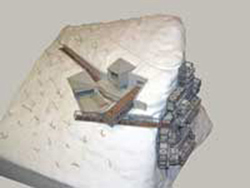

Starting my degree thesis, the choice of the building plot was done after wandering through the wider area where we can also find the investigation area of my in-depth research, Makrinitsa. The rock with its dramatic elevation constitutes a very important characteristic of the area that is also easily seen from all the near Pelion villages. Then, it was necessary to ‘read’ the near environment so as to find the most appropriate solutions for the morphological, conceptional and constructional adaption of the new intervention to the existing building and natural environment. The main features of the architectural and poleodomical tradition of Makrinitsa, the landscape that predisposes for installations of alternative tourism, with the brook, the existing hiking routes, the existing climbing arena, the simple constructions (cottages) that rest disseminated and also the rock itself (a part of which is proper for climbing), which refers to the various monasterial installations located to similar abrupt landscape are some of the features that influenced more or less the process and the final result of this project.
The main building plan consists of four basic functions, conference and athletic center, restaurant and lodges. The main room of each-one of these functions are discernible from the different materials concerning the rest building and from the morphology of the lumps that are discreet from the outside. All the functions apart from the lodges are located at the rock’s spine, whereas the lodges are positioned to a metallic frame anchored to one of the armfuls that are created from the elevation of the rock. These two basic parts of the installations are connected with one square that acts as reference point. The metallic constructions, giving an ephemeral sense, the volumes that give the impression that at these points the rock skins at its spline, consisting its continuity, the lodges that seem to rest to the rock which at the same time they climb over it, the game of the projections and the alteration of open, semi-open and closed places, are some of the partial characteristics, as a result of the study that mentioned previously.
Finally, the main ask that occupied me from the start concerning the identity of the new intervention is the attitude that should be kept opposing to the architectural tradition that is conveyed by the traditional villages of the Pelion and Makrinitsa. As it has been said, some of the basic general features has been transferred adapted to the present architecture. In other words, to another tradition, the tradition of today. This solution was thought as the best one, as Makrinitsa is there standing consisting an attractive pole for what means and for what everyone wants to know. So, the new intervention was better to create a different event and through this difference the new and the traditional would be shown more.
Supervisors: Philippitzis Dimitris, Triantafillidis Giorgos
Reference Number: 277
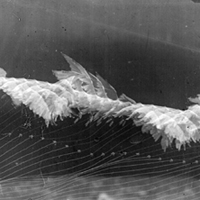

In this diploma project the compositional procedure is based on human body’s movement. More specifically, walking, that basic way of shifting in space, is being observed and variated as for its stable rhythm of repetition through the creation of a topography of various sequential inclinations.
The morphology has been studied through physical and three - dimensional models as well as in 1:1 scale, taking into consideration the attributes of walking and the possibility of space creation through movement and its trace. The research phase guided in the composition of a space consisted of successive sequential sections that are placed one next to the other.
A park of kinetic recreation is redesigned where a children playground park is now sited at Analipsi region in Thessaloniki. The design intensions tend to combine both existing and desirable situation of the park considering and reconnecting the pedestrian routes of the urban space around it. Finally, the way that typical playground structures can move is isolated and readapted in the new structure.
Supervisor: Gavrilou Evelyn
Reference Number: 301
The aim of this work is to design in a location of Lagonisi (South of downtown Athens, next to the Saronic Gulf Coastal Highway) a community, which can extend hospitality to artists-thinkers. The community is formed by three regions. The first region is the commercial zone that is formed by shops, spaces with important services, an underground parking and a metallic formed surface. The commercial zone connects the community with the other region as people who use it are the inhabitants of the community also are the inhabitants of the generally region.
The second region is a 45 meters width zone that exists in the central part of the site and follows the natural shape of the site, in this zone are placed all the housing units and the working units. A road that passes through the middle of this zone divides in two parts. Because of the intense inclination of the ground, stone walls with 1 meter width are placed that take the inclinations and with stairs that cuts the stone walls in the point of the road can take someone in a higher level. The site that belongs in each residence contains a residence unit, one or two shelters with seats, trees and bushes that provides insulation at each residence. They are designed six different types of residence units, although their shape is different, they have all two floors and contain the same spaces.
In the north side of the site next to the road are designed open air parking positions for the residences of the community and for their visitors. With the road that is in the north side of the site are connected internal roads that leads into the residential zone so they can cover the residential needs. Also in the north side of the site is designed an athletic exercise area with dimensions 61,90 × 28 meters that contains four tennis courts for the exercise of the residence of the community. In the south side of the residential zone are designed water cisterns. These cisterns are small constructions that contain a water cistern and a linear shelter; they are three different types of water cistern.
The third region is in the east side of the site and contains a formation with curve levels in the ground plan and in the view. The main use of this formation is the recreation and the rest of the people who live in of the community.
Supervisor: Stylidis Iordanis
Reference Number: 291


This thesis is on designing a modern recycling and paper manufacturing plant, in the industrial area of Volos. The aim of this thesis is the ecological approach of the paper recycling and production, and the enhancement of the factory in order to attract different visitors and, thus, to promote recycling in Magnesia. In the context of siting the factory, special attention was given to the stream and the old train lines that cross the site along its length. The building is linear, with dimensions of 400 x 50 meters. The main part consists of a shell that houses the production line, and the office spaces are concentrated in a separate building attached to the shell. The access to the site is made by two bridges, and the entrance to the factory by the building of offices and the two ends of the factory. Also attention is given to the landscaping, surrounding the factory, and the harmonious integration of the natural environment. This is achieved by developing the existing stream and tree planting the two banks that will constitute walking and relaxing area for employees and for visitors.
Supervisor: Triantafillidis Giorgos
Reference Number: 276

